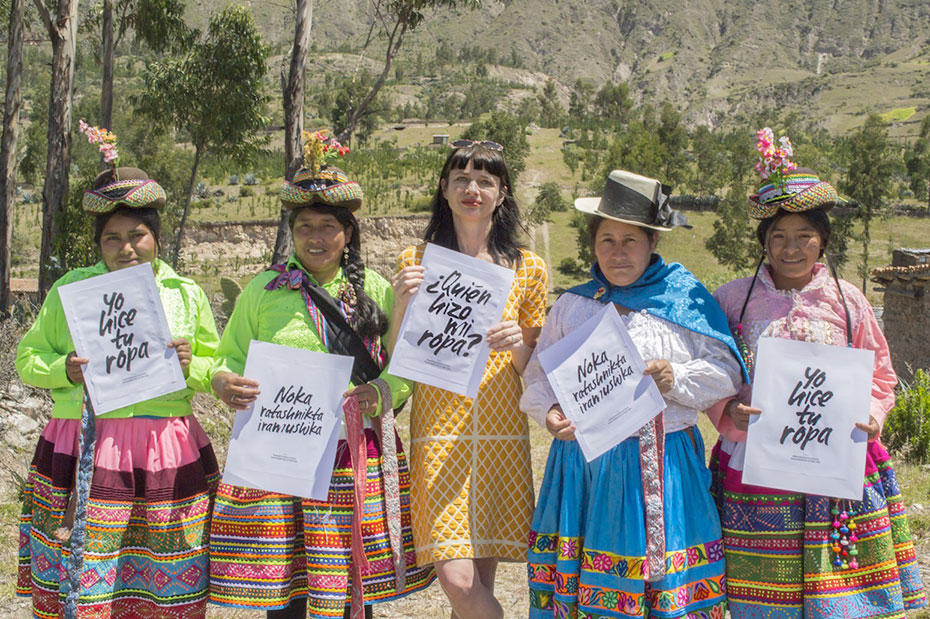Seasons Greetings from S4S
Why buy a Christmas jumper from the stores when you can make one yourself from reclaimed and second hand clothing and fabric? In this blog post, one of our S4S participants, Anne Bowen, showcases her wonderful new upcycled Christmas jumper and provides us with step-by-step instructions. We hope you feel inspired by Anne’s great work. We wish all of our team and all or our supporters a very merry Christmas and all the best wishes for 2020.
Stacey Dooley Investigates Fast Fashion
It’s funny how when you begin to look at something, all of a sudden everyone seems to be looking at it! Only 2 weeks ago S4S prepared a PowerPoint presentation to launch the Second-hand and Ethical workshop series happening at Krowji in Cornwall. One of the slides showed a photograph of the devastating environmental impact of over farmed land for cotton, namely the Aral Sea Basin. The Aral Sea is the world’s largest endorheic lake which sits between Kazakhstan and Uzbekistan and has been intensively farmed for cotton for the fast fashion industry. Poor irrigation and land management has tragically caused the lake to dry up almost completely leaving a desert where there was once rich shipping waters In the same week, a programme by BBC 3 documentary presenter Stacy Dooley, ‘Stacey Dooley Investigates – Are Your Clothes Wrecking the Planet?’ is aired telling the cataclysmic story of how over consumption of fast fashion is the driver behind this and other environmental catastrophes. Following the television show, sustainable fashion champions, Fashion Revolution amongst other campaigners for change within the industry have applauded Stacey publicly on Twitter for taking the issue up and going mainstream, allowing exposure of the critical nature of the continued corporate fast fashion consumption agenda and it’s devastating consequences. More can be found about the programme here; https://www.bbc.co.uk/bbcthree/article/5a1a43b5-cbae-4a42-8271-48f53b63bd07
Parliament is Looking at Sustainable Fashion and the Environment
The Environmental Audit Committee is a Parliamentary body that has been established to investigate the social and environmental impact of disposable ‘fast fashion’ and the wider clothing industry. The inquiry is scrutinising the environmental cause and effect of carbon, resource use and water footprint of clothing throughout its lifecycle. It will explore the possibilities of how clothing can be recycled, and waste and pollution reduced. A panel of experts meet in Parliament to continue discussion specifically about the problematic effects of microfibres leached into our water tables through continual laundering of synthetic and man made fibres. This important meeting can be viewed here; https://parliamentlive.tv/Event/Index/d898bd30-5048-41d2-ac01-5280591642e6 Learn more about the Environmental Audit Committee and Sustainable Fashion here; https://www.parliament.uk/business/committees/committees-a-z/commons-select/environmental-audit-committee/inquiries/parliament-2017/sustainability-of-the-fashion-industry-17-19/
Cotton Dyeing – A New Innovation for Good?
Recently a relatively new company ColorZen® was given the Innovation Award at the Copenhagen Fashion Summit. This was for their leading edge technology which allows cotton fibre to absorb dye much quicker with less toxic waste produced. With water pollution and resource consumption being the biggest issue surrounding cotton production, this could be a major leap forward in changing the old existing unsustainable and toxic colouration methods for this globally loved fibre. The Manhattan based company is headed by CEO Michael Harari who came from a real estate background to join his father’s textile manufacturing interests. According to an interview with Crain’s New York Business Harari suggests that “cotton can be coloured using 75% less energy, 90% less water and much less dye.” The old problems associated with cotton dyeing lie in the fact that the plant itself, as with all other ‘cellulosic’ fibres such as linen, hemp, bamboo etc, cannot absorb the dye pigment readily. They transmit a powerful negative electrical charge which resists colour pigment just like the opposing ends of magnets. Therefore large amounts of salt are required to assist the dye to stick to the fibre. This process takes extra resources, time, energy and results in half the dyestuff going to waste. The Crain’s report states that The World Bank estimates that textile-dyeing introduces as many as 72 toxins to the global water supply, and as we are discovering, most of the fashion industry’s dye-houses are overseas where environmental regulations are not regulated. So the news that ColourZen can reduce the amount of dye and toxic chemical waste as well as the time and energy used to colour cotton is a breakthrough. But what is their secret and how are they doing this? They are using a once maligned product made by Dow Dupont called CHPTAC. Rejected originally because of it’s overpowering fishy stench, Dow Dupont have created a new non-smelly version. CHPTAC works by changing the molecular structure of the cotton fibre to allow it to absorb the dye – effectively breaking the repelling force that the plant emits. But like all chemicals CHPTAC comes with it’s own set of toxic and dangerous hazards. CHPTAC, or N-(3-chloor-2-hydroxypropyl)-N,N,N-trimethylammoniumchloride, is reported to give off poisonous vapour when heated, and it’s a potential carcinogen, according to the Centers for Disease Control and Prevention. But Harari assures all workers at ColorZen’s North Carolina factory are fully protected against possible hazards, and the firm’s contract manufacturer, Jabil, best-known for making iPhones, has a strong safety record. It seems that there’s a fine balancing act to try to negate one toxic process with another in the textiles manufacturing worlds and while the consumer still demands coloured cotton clothing, the battle to save the environment from chemical destruction continues….
S4S Project Deliver Paper PSA Conference Event
Today at Nottingham Trent University, members of the the S4S project team, led by Prof Clare Saunders will attend the 69th Political Studies Association (PSA) Annual International Conference event to represent the Designing a Sensibility for Sustainable Clothing project by delivering a paper about the findings so far revealed by the research the project has done. The three day event titled, ‘(Un)Sustainable Politics in a Changing World’ will cover themes ranging from the topical hotbed of Brexit related issues through to environmentalism, youth politics, misogyny and gender. The paper can be read here…
Fashion Revolution’s Consumer Survey Report Released
This month Fashion Revolution, the global advocates for making the fashion industry and it’s workers rights sustainable, ethical and fair, released it’s 2018 Consumer Survey Report. The downloadable PDF comes in two formats, 1. The Full Report and 2. The Results – so there’s something for everyone here and that people with all levels of interest can pick up something useful and meaningful to them. The release of the report coincides with the co-founder and Global Operations Director, Carry Somers making an appearance on British TV show BBC’s Breakfast, saying “Transparency is key. If we can’t see what’s happening, then we can’t fix it.” And she’s absolutely right. The report’s timely arrival also met with the first oral hearing of the Environmental Audit Committee’s ongoing enquiry into the fashion industry. This hearing, which has been preceded with written reports and oral evidential panel submissions from leading academics, designers and figures from the fashion and textiles sector, saw CEO’s and representatives of UK fast fashion giants like ASOS, Primark, and Misguided held to question alongside more ‘respected’ iconic British brands Burberry and Marks & Spencer about their manufacturing and retail ‘practices’. The Parliamentary panel, chaired by MP Mary Creagh, grilled the company heads and reps about over-production, workers rights, failure to liaise with external organisations who are campaigning to change the industry for the better from within and a range of highly sensitive and topical matters. All of this current media exposure to the burgeoning awareness in the mainstream about the acute environmental and ethical issues rife across the whole sector ironically comes in on the wake of a tidal wave of Black Friday sales and deals. The tug-of-war for consumer’s brand loyalty and ethical conscience is happening and it’s a complicated and emotional dilemma for many consumers. On one hand, everyone wants to look good and get a great deal for buying clothes but at the same time, no one really wants to add to environmental destruction or be complicit in enslaving garment industry workers in life-threatening working conditions or illegal bonded labour. The wonderful thing about Fashion Revolution’s report is that represents a broad spectrum of consumers across the globe and finally gives them a voice amid all of the ‘official’ industry scrutiny. It’s presented in readable and easy to grasp terms that mean something to all who don’t necessarily think about manufacturing supply chains and technical processes. It’s a step in the right direction and a model of hope in a complex mass of problems. Download the report and find out more here… https://www.fashionrevolution.org/wp-content/uploads/2018/11/201118_FashRev_ConsumerSurvey_2018.pdf









